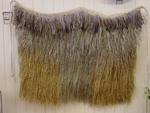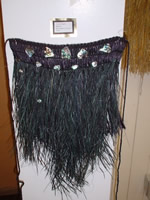
Paula Rigby is a skilled weaver, with years of experience creating beautiful items from natural fibres of harakeke or flax, feathers, and more contemporary fibres. Matariki is a time when weaving was taught and practised, and garments were made using the fibres prepared in the previous year.
In this interview she shares her knowledge of the role of the weaver in traditional Māori society, takes us through the process of making a korowai or cloak, and tells how stories and families are woven together in garments often made by many hands.
Gather in the summer
Typically for a fibre artist, you gather in the summer and you prepare in the summer, because we can’t cut flax when it’s raining or wet, so in the winter you’ve got all this prepared fibre to weave with. That’s what Matariki’s about — Matariki’s when the wananga happen, so the schools were happening to teach oratory, to teach whakapapa, to teach weaving, and other, different skills.
It was also a time to reflect and to plan for next year, and plan your planting. With garlic, you plant on the shortest day - that’s a tradition that comes with garlic so we have our own traditions, with kumara and a whole lot of other things and they (the traditions) revolve around the sighting of that star sign of Matariki.
Paula is a Christchurch City Council Māori arts adviser is based at the Christchurch Art Gallery, after years of work as a teacher and a degree in education.
Most art work is functional, Paula says:
It’s either recording a moment in time or place, or you can actually sit on it, or use to carry food … A lot of Māori art was functional it was clothing, it was baskets to carry food in and now we’ve converted those baskets into the beautiful kete that people carry around as their evening handbag … It’s taken a long time to get us out of that craft field and into being recognised as an art form. The degree of skill that’s involved in making a korowai (cloak) for example is phenomenal, and it should be recognised as just as artistic as a van Gogh or Rembrandt.

Weavers held in high regard
Weavers were a valuable part of traditional Māori society, Paula says.
If you were a renowned weaver in your area you gave huge economic benefit to your community, your iwi or your hapu your weaving would be traded for food, to add to food stocks. There are examples of Māori weavers being married into other whanau to help quell conflict or infighting they had quite a high status in the village.
Most women’s artwork in the Pacific is communal, and Māori weaving was no different. In the Pacific Island community if you look at the Rarotongan and their tivaevae practice of making those beautiful embroidered quilts, that is a community experience. You always have one person in charge of the design and the look and the feel of the article, but many help to make it happen.
A lot of the time with the weaving that I’ve been involved in, we’ll meet as a collective and prepare, but when it comes to actually making the garment itself it’s usually one person’s concepts. If you’re helping that person you’re still bringing out what they see, not adding your own influences into it. You try to keep it up to their standards as far as possible.
Preparing to make a korowai
Korowai, or cloaks, and the prized kakahu, the feather cloak, could take years to make, and involve large numbers of weavers.
Preparing for that, you’d need to go out and cut flax - a process that could take months because we’re talking about at least 700 whenu (the downstrings that we use to make the body of the garment) and then a couple of thousand aho (which are your horizontal lines). So what we do with the flax is we extract the fibre from it and then we roll it into cords by rolling it on our legs. So that whole process can take a few months to get it ready to go.
Then on top of that, if you’ve decided that you want to put feathers on top of your coat you have to prepare your feathers. A fully feathered cloak can take up to eight birds or more. You have to decide on how you want them to sit there are a couple of different ways of getting them to sit together and we always use at least two feathers together, so they have to be prepared.
Then it’s (creating) the whole look of the garment and away you go. Then the weaving itself, depending on the speed of the weaver that can take another few months.
Some cloaks take years. It’s very, very time consuming and the feathers can be hard work. You do it in short bursts.
The only time I’ve ever done all my feathers at once was when making whanau cloak when all the kids, all the grandchildren, nieces and nephews sat at the table and they were so intrigued with what I was doing they wanted to help. So we showed the kids what to do and when our whanau cloak is finally made, we can say all our kids were involved and their mums and dads and their grandparents had been involved in making this cloak it really does belong to the whole family, and not just to one particular weaver …
I was really impressed with the kids, some of them are quite young, under five, and they did a very professional job, and as they were doing it we were talking about why are we doing this and how when you get married, or graduate from university, or when you do something really special in your life and you have a special ceremony and you’d like to wear a special garment like this we’ll have one in our family. So they did a really good job because they realised how important it was.
Weaving as art
The process of making the cloak and sharing the knowledge of how to make it and what it means is important.
A lot of our garments these days carry names because we want to acknowledge them to lift its mana I suppose. You’re spending so much of your life doing the work, that you’re actually weaving a bit of yourself and weaving stories into the work as well. I guess that’s why we want this broader term of art work for the work that we do people might look at it and think it’s a cloak, it’s a piece of clothing, but it actually does carry a history and a story and all of those kinds of things like some of the artworks that are hanging here in the gallery.
I’ve made a lot of cloaks using contemporary fibre, and I’ve really enjoyed that. I enjoy making pake, raincapes, and just using harakeke and other different fibres neinei which you can get in the alps, and poa, which is a grass that you can get from the alps as well we have pingao, which comes from the beach and kuta, which comes from the rivers and the lakes. They’re all great fibres to work with and make garments with.
And then it’s like anything. You start experimenting with dyes and you’ve got a whole new mix into the thing…
Traditional and contemporary
People have sort of rubbished the contemporary work, but we (weavers) say as soon as wool arrived, you can see in the museum cloaks that our weavers started using wool. As soon as metal tools came, we used them, hoes and spades they could see the value in it and it gave them more time.
We have weavers weaving garden hose and you name it they’ve tried it, just to see what it’s like and how it looks and you’ll use something and think yuck I’m not going back there again or you’ll think wow, that was really cool and I’ve come up with twenty different ways of doing things. And we’ve always got the trendsetters and innovators … there’s been a recent influx of people using traditional fibres and copper wire. There’s no doubt that’s going to move on and on and people are just going to keep trying new things.
Some aspects of fibre art will remain traditional though there’s no reason to change for the sake of change:
The best thing we have in the whole world to extract the fibre from the flax is the mussel shell. And people have tried other things but the mussel shell works every time, you get the same result and it comes with a left-handed side and a right-handed side. It’s perfect, and usually they’re free. Knives don’t work as well, there are people who use knives, but it takes quite a while to master that technique. The mussel shell is perfect you carry it on the plane too they tend to take your knives off you.
With more and more people focusing on sustainability and preserving the environment as part of their every day lives, Paula points out that fibre artists were careful with the environment.
Weavers are very, very conservation orientated everything that we do from the moment that we start to take the flax from the flax bush to the finish product is done with conservation in mind. So when we take from the plant, we take in a way that helps that plant to regenerate and grow. With all the left-over stuff, we try to find innovative ways of using it so it's not a waste by-product. You can make tiny wee earrings and things out of the leftover bits of flax there’s always a use for it.


Add a comment to: Weaving art and lives together